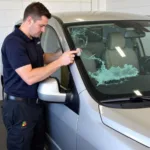Cracked car paint is an unsightly problem that can detract from your car’s appearance and even lead to further damage like rust. Knowing how to repair cracked car paint yourself can save you money and keep your car looking its best. This guide will walk you through the steps to effectively repair cracked paint, from assessing the damage to applying the final touches.
Repairing cracked paint on your car doesn’t have to be a daunting task. With the right tools and a little patience, you can achieve professional-looking results. Let’s dive into the details of how to tackle this common car paint issue. repair cracked paint on car
Assessing the Damage: The First Step in Cracked Car Paint Repair
Before you begin the repair process, it’s crucial to assess the extent of the damage. Is the cracking superficial, affecting only the clear coat, or does it extend deeper into the base coat or even the primer? The depth of the cracks will determine the necessary repair approach. For minor cracking, a simple touch-up might suffice. However, deeper cracks may require sanding, priming, and repainting the affected area. Look closely for any signs of rust, which will require additional treatment before painting.
Gathering Your Supplies: Essential Tools for Car Paint Repair
Once you’ve assessed the damage, gather the necessary supplies. You’ll need sandpaper (various grits), primer, car paint (matched to your car’s color), clear coat, rubbing compound, polishing compound, masking tape, a tack cloth, and applicator tools like brushes or spray guns. Investing in quality materials will ensure a better and more durable repair.
How to Repair Minor Cracks in Your Car’s Paint
Minor cracks, often appearing as hairline fractures in the clear coat, can often be addressed with a touch-up paint pen or brush. Carefully clean the area with soap and water, then dry it thoroughly. Apply the touch-up paint in thin layers, allowing each layer to dry before applying the next. Once dry, use rubbing compound and polishing compound to blend the repair seamlessly with the surrounding paint.
What if the Cracks are Deeper? Repairing Extensive Paint Damage
For deeper cracks that penetrate the base coat or primer, more extensive repair is required. Start by sanding the affected area with progressively finer grits of sandpaper until the cracked paint is removed and the surface is smooth. Then, apply primer to the sanded area, allowing it to dry completely. Next, apply several thin coats of car paint, followed by clear coat. Finally, use rubbing compound and polishing compound to achieve a smooth, glossy finish.
Preventing Future Paint Cracks: Protecting Your Car’s Finish
Prevention is always better than cure. Regularly waxing your car can protect the paint from UV damage, a common cause of cracking. how to repair paint cracks on car Avoid parking in direct sunlight whenever possible. Washing your car regularly and addressing minor chips and scratches promptly can also prevent cracks from developing.
How Long Does it Take to Repair Cracked Car Paint?
The repair time depends on the severity of the damage and the chosen repair method. Minor touch-ups can take a few hours, while more extensive repairs might require a day or two, including drying time between coats.
Can I Use Any Type of Car Paint for Repair?
No, using the correct paint code for your car is crucial for a seamless repair. cracked paint on car repair This code can usually be found on a sticker inside the driver’s side doorjamb or in your car’s owner’s manual.
“Matching the paint code precisely is essential,” says renowned auto body specialist, John Miller. “Using the wrong paint will result in a noticeable mismatch, negating the purpose of the repair.”
Conclusion: Maintaining a Flawless Car Finish
Repairing cracked car paint is a manageable task that can significantly improve your car’s appearance and protect it from further damage. By following the steps outlined in this guide, you can achieve professional-looking results and save yourself the cost of a professional repair. Remember to prioritize prevention by regularly waxing your car and addressing minor paint imperfections promptly. How to repair cracked car paint effectively hinges on careful preparation, the right materials, and a bit of patience. repair cracked paint on car bumper
 Polished Car After Paint Repair
Polished Car After Paint Repair
FAQ
- What causes car paint to crack? Exposure to UV rays, extreme temperatures, and impacts from road debris are common causes.
- Can I repair cracked paint in direct sunlight? No, it’s best to work in a shaded area to prevent the paint from drying too quickly.
- What happens if I don’t repair cracked paint? The cracks can worsen, leading to rust and further damage to the car’s body.
- Do I need to sand before applying touch-up paint? For minor cracks, light sanding might be sufficient, but deeper cracks require more thorough sanding.
- How can I prevent car paint from cracking? Regular waxing, avoiding direct sunlight, and addressing minor chips promptly can help prevent cracking.
- What type of sandpaper should I use for car paint repair? Start with a coarser grit (e.g., 180-grit) and gradually move to finer grits (e.g., 2000-grit) for a smooth finish.
- Can I use a hairdryer to speed up the paint drying process? While it might seem tempting, using a hairdryer can cause the paint to dry unevenly and create imperfections.
“Prevention is key when it comes to car paint,” adds Maria Sanchez, a leading expert in automotive paint care. “Regular maintenance can save you a lot of trouble and expense in the long run.”
For further information on specific car paint repair scenarios, you might find these articles helpful: Car Paint Repair Carlton.
Need assistance with your car repair? Contact us via WhatsApp: +1(641)206-8880, or Email: [email protected]. Our customer service team is available 24/7.


